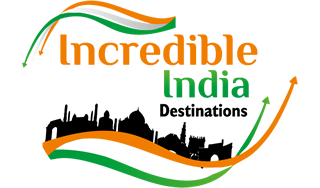Itinerary
Day 1 Exploring Delhi!
You will arrive at the Delhi Airport. Delhi is India’s national capital and the second-largest metropolis after Mumbai. Delhi has been continuously inhabited since the 6th century BC. Throughout most of its history, Delhi has served as the capital of various kingdoms and empires. It has been captured, ransacked, and rebuilt several times, particularly during the medieval period, and modern Delhi is a cluster of several cities spread across the metropolitan region.
Upon arrival, you will be transferred to your hotel and after a quick break, you will start your sightseeing.
On your first day, you will explore the old and new cities of Delhi. You’ll be mesmerized by the 100-feet, red-stone boundary walls of Red Fort built during the 17th century. Opposite to this ancient structure is Jama Masjid (Mosque), built in 1656 AD, construction of red sandstone and white marble. It is the largest mosque in India where 20,000 people can pray together at a time. You will also tour the city in a Rickshaw. Along the streets of old Delhi, you will see the Raj Ghat, and Mahatma Gandhi (Father of the Nation) Memorial, which is close to the river Yamuna. Next, you will visit Humayun’s Tomb, the tomb of the second Mughal emperor, which was built by his wife during the 16th century, and then you will visit Qutub Minar, a 220-feet tower made by one of the first Muslim leaders in India, built between 1199 and 1368 AD. It runs counter to Rashtrapati Bhawan, the residence of the President of India. There you’ll also see the Government Buildings and Parliament. An overnight stay in Delhi. Delhi – Agra Tour Package
India is the land of many religions so to explore e religious side of our mystic country, after an early breakfast; today you will visit Gurudwara Bangla Sahib which is the most prominent Sikh Gurdwara, or Sikh house of worship, in Delhi, known for its association with the eighth Sikh Guru, Guru Har Krishan, and the pond inside its complex, known as the “Sarovar”, whose water is considered holy by Sikhs and is known as “Amrit”. It was first built as a small temple by Sikh General, Sardar Bhagel Singh in 1783, who supervised the construction of nine Sikh shrines in Delhi in the same year, during the reign of Mughal Emperor Shah Alam II. This is followed by visit to The India Gate is the national monument of India. Situated in the heart of New Delhi, the India Gate was designed by Sir Edwin Lutyens. It is inspired by the Arc de Triumph in Paris. It was built in 1931. Originally known as the All India War Memorial, it is a prominent landmark in Delhi and commemorates the 90,000 soldiers of the Indian Army who lost their lives while fighting for the Indian Empire, or more correctly the British Raj, in World War I and the Third Anglo-Afghan War. It is composed of red and pale sandstone and granite.
The next place that you’ll visit is The Lotus temple (a.k.a Bahá’í Temple) which is open to all, regardless of any religion, or any other distinction, as emphasized in Bahá’í texts. The Bahá’í laws emphasize that the spirit of the House of Worship be that it is a gathering place where people of all religions may worship God without denominational restrictions. The Bahá’í laws also stipulate that only the holy scriptures of the Bahá’í Faith and other religions can be read or chanted inside in any language; while readings and prayers can be set to music by choirs, no musical instruments can be played inside. Furthermore no sermons can be delivered, and there can be no ritualistic ceremonies practiced. An overnight stay in Delhi.
Day 3 Drive from Delhi – Agra (200 Km /2-3 Hrs)
After breakfast, you will visit Akshardham is a Hindu temple complex in Delhi, India. It is also called Delhi Akshardham or Swaminarayan Akshardham, the complex displays millennia of traditional Indian and Hindu culture, spirituality and architecture. The building was inspired and moderated by Pramukh Swami Maharaj, the spiritual head of the Bochasanwasi Shri Akshar Purushottam Swaminarayan Sanstha, whose 3,000 volunteers helped 7,000 artisans construct Akshardham.
Then you will drive to Agra, the “City of Taj” you will visit Sikandra The Tomb of Akbar the Great is an important Mughal architectural masterpiece, built 1605-1613, set in 48 Ha (119 acres) of grounds in Sikandra, a suburb of Agra. Upon your arrival, you will be transferred to your hotel.
In the evening you will visit to the Mehtab Bagh (Taj Mahal from the other side of the river) and the tomb of Itmad-ud-daula Often described as ‘jewel box’, sometimes called the ‘Baby Tāj’, the tomb of I’timād-ud-Daulah is often regarded as a draft of the Tāj Mahal. The mausoleum was commissioned by Nūr Jahān, the wife of Jahangir, for her father Mirzā Ghiyās Beg, originally a Persian Amir in exile. An overnight stay at Agra.
Day 4 Full day sightseeing of Agra
Early morning you will visit the world-famous Taj Mahal (1631-1653). This amazing piece of architecture made of white-colored marble, was built by Mughal ruler Shah Jahan for his departed wife Mumtaz Mahal. Its architecture reveals why it’s one of the Seven Wonders of the World. For 22 years, 20,000 expert workers from Italy, France, Iran and Asia worked on the memorial. Return to hotel for breakfast.
After the breakfast, you will visit Agra Fort at the west bank of the Yamuna River. The Agra fort was built in the 16th century by Akbar and was completed by his grandsons. Delhi – Agra Tour Package
Note: The Taj Mahal is closed on Friday.
After the sightseeing, you will drive back to Delhi.
